Kendo Is the Art of the Sword Iaido Is
Kendo - 剣道
"The Warrior Within"
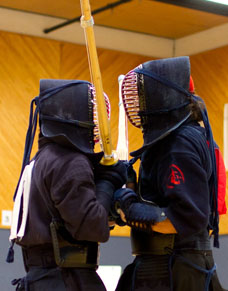
A true warrior has no confusion in his mind…
No Martial Art symbolizes the spirit of the warrior more than than the fine art of kendo ("The way of the Sword"). Although the metal swords have been replaced by bamboo and wood, all other aspects of the Samurai Spirit live on in the practice of Kendo.
Hollywood movies such every bit "The Last Samurai" exposed the art of Kendo to a huge audience, many of whom are unaware that over xl countries participate in a world Championship, and 10 one thousand thousand do worldwide.
Kendo requires a strong spirit, physical force and attitude to avoid defeat; Each attack is undertaken as it would have been from the Samurai, where expiry is the only outcome.
Strike a killing accident requires good technique, but victory requires a single mindedness to defeat the opponent. In Kendo such courageous attacks develop the spirit which is necessary for victory.
-Excerpt from "The Empty Listen Films" by Jon Braeley
What is Kendo ?
We believe these introductional videos might assist you get started on the "The manner of the sword" :
"Be better today than y'all were yesterday and and so strive to become improve even so, never lose your spiritual equilibrium cultivate a mentality that allows you stay alarm in every state of affairs..."
The way of the sword
Kendo (剣道) literally means "The way of the sword" in Japanese. It refers to the art of traditional Japanese fencing that was originally developed and practiced past Bushi or Samurai. Kendo originated from the various sword fighting techniques of hundreds of years of combat and written report. It deals with the concrete and mental skills necessary for sword fighting. The goal of Kendo is non only to develop the physical capability for fighting but besides the moral and spiritual aspects that may be applied in coping with real life. In Japan, it is one of the most popular martial arts. Kendo has spread to other parts of the globe such as North America and Europe. It has developed a strong post-obit in Canada and in Quebec as well. Kendo is continually growing in popularity worldwide.
"Development oe Kendo"
NHK Sports Japan - Evolution of Kendo
Interview" with Yukiko Takami
KENDO - Yukiko Takami/Interview - IS Japan COOL? DOU (剣道 - 鷹見 由紀子)
"Working within"
"This is the forge"
History of Kendo
It is difficult to precisely say when and how Kendo originated. Kendo was not created nor developed by a single person or even a group of people. Information technology was developed over a very long period of time from existent gainsay and sword fighting situations.
The sword was introduced to Nihon from the Continent around the 2nd century BC. They say that the sword was originally a ritual colored object which symbolized the potency of its owner rather than a weapon. At that time, the catapult and bow were used for hunting or tribal warfare. However, the sword gradually became used for fighting through continuous group conflicts in the form of national unification. By the 7-8th century, the sword was being forged domestically.
After the ninth century, as the Bushi form was established, the prototype of the Japan-to (the Japanese sword) was formed. Various sword fighting techniques likewise as forging techniques had been developed. However, on the battlefield, swords that were longer than 6 anxiety and spears were the primary weapons until the 14th century.
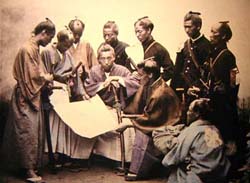 | The years that followed were filled with civil wars, and it was during these times that schools of Kenjutsu, literally meaning the art of the sword, began. These schools were started past diverse chief swordsmen, and each school had its ain manner unique to the originator. As the years passed and more peaceful times prevailed, more than emphasis was placed on the spiritual aspects through the practice of Kenjutsu. These moral and social aspects stemmed from Zen Buddhism and Bushi-do (the way of the warrior) whose principle ideas were based on Confucianism. |
Since Samurai warriors were the only class allowed to behave a sword, mastering the sword was indispensable for any respected Samurai, in fact, information technology was considered to literally represent the spirit of Bushi.
| During the second one-half of the 18th century, the first existent protective equipment came into being. These developments in protective equipment and the usage of Shinai (the bamboo sword) played an of import role for the evolution of Kenjutsu practise. In the concluding days of the Tokugawa Shogunate, equally the awareness for the demand for national defense was growing, Kenjutsu became pop even amid non-Bushi-class citizens. After the Shogunate government was abolished in 1867, modern Japan was formed and the Bushi class became extinct; the correct to bear a sword was also banned. As a result, Kenjutsu temporarily declined in popularity. All the same, on suppressing the rebellion that bankrupt out in 1877, the achievement of constabulary officers who mastered Kenjutsu was highly respected. At the same time, there was a need to enhance the wealth and military machine force on a national scale in lodge to compete with the Great Powers of the globe. | 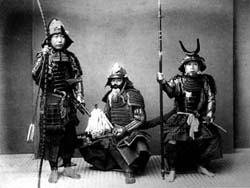 |
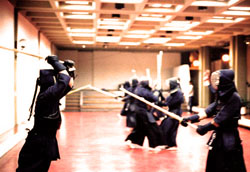 | Under such circumstances, the promotion of Kenjutsu was reexamined. In 1879, the Metropolitan Police Agency of Tokyo began giving Kenjutsu courses for its officers. In 1895, Dai Nippon Butoku Kai was formed equally an organization devoted to all martial arts. However, the popularization of Kenjutsu demanded a universal course, one that would include and integrate all existing schools of Kenjutsu. In 1912, after a long deliberation amid masters of major Kenjutsu schools, a new arrangement of Kenjutsu that transcended existing schools was established. This is the nascence of Kendo. Since and then, Kendo has officially become part of the physical didactics program initially at the secondary school level, and then in principal schools. Equally a result, Kendo flourished, and many tournaments were held all over Japan. |
| After World War Ii, Kendo suffered a major setback. Kendo was regarded undemocratic past the general headquarters of the occupation forces and was officially banned in public. In 1957, due in part to the efforts of many Kendo enthusiasts, Kendo was restored. In the same yr, the All Japan Kendo Federation was founded. Kendo grew into a national past-fourth dimension again. Nonetheless, information technology was now more of a martial art concerned primarily with the development of mind and torso with the purpose of forging a ameliorate life rather than a method for taking life using a sword as information technology was earlier. | 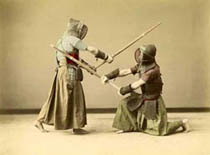 |
At present, since the establishment of the International Kendo Federation in 1970, Kendo has become popular fifty-fifty outside of Nihon. Countries such equally Canada, Brazil, England, French republic, Germany, Korea, the Usa, and many others have begun practice Kendo. There are many more federations exist internationally, every bit people in other countries accept increasing interest in Kendo. Modern Kendo is the result of many changes, from a purely fighting fine art, to an all encompassing martial fine art.
cabralessuplined1987.blogspot.com
Source: https://www.shidokanmontreal.ca/conceptkendo.html
0 Response to "Kendo Is the Art of the Sword Iaido Is"
Publicar un comentario